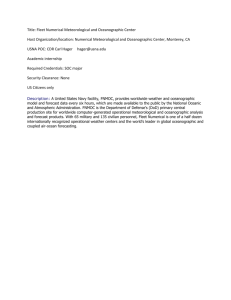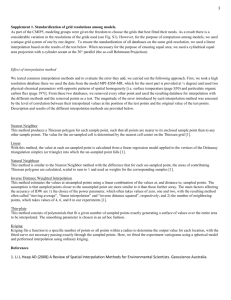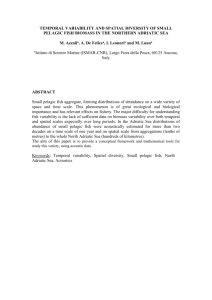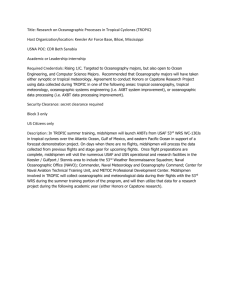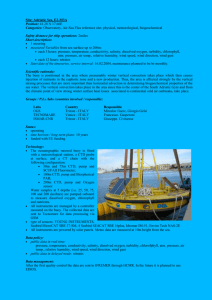V. Dadić1, M. Srdelić2, and Z.Gržetić2
advertisement
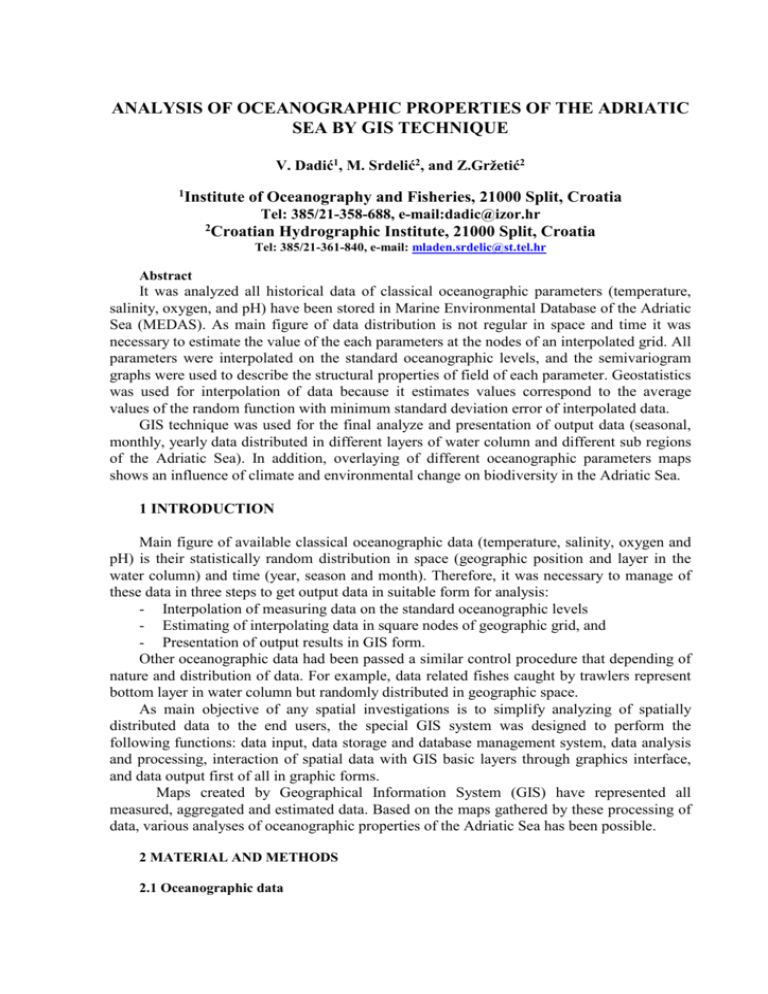
ANALYSIS OF OCEANOGRAPHIC PROPERTIES OF THE ADRIATIC SEA BY GIS TECHNIQUE V. Dadić1, M. Srdelić2, and Z.Gržetić2 1 Institute of Oceanography and Fisheries, 21000 Split, Croatia Tel: 385/21-358-688, e-mail:dadic@izor.hr 2 Croatian Hydrographic Institute, 21000 Split, Croatia Tel: 385/21-361-840, e-mail: mladen.srdelic@st.tel.hr Abstract It was analyzed all historical data of classical oceanographic parameters (temperature, salinity, oxygen, and pH) have been stored in Marine Environmental Database of the Adriatic Sea (MEDAS). As main figure of data distribution is not regular in space and time it was necessary to estimate the value of the each parameters at the nodes of an interpolated grid. All parameters were interpolated on the standard oceanographic levels, and the semivariogram graphs were used to describe the structural properties of field of each parameter. Geostatistics was used for interpolation of data because it estimates values correspond to the average values of the random function with minimum standard deviation error of interpolated data. GIS technique was used for the final analyze and presentation of output data (seasonal, monthly, yearly data distributed in different layers of water column and different sub regions of the Adriatic Sea). In addition, overlaying of different oceanographic parameters maps shows an influence of climate and environmental change on biodiversity in the Adriatic Sea. 1 INTRODUCTION Main figure of available classical oceanographic data (temperature, salinity, oxygen and pH) is their statistically random distribution in space (geographic position and layer in the water column) and time (year, season and month). Therefore, it was necessary to manage of these data in three steps to get output data in suitable form for analysis: - Interpolation of measuring data on the standard oceanographic levels - Estimating of interpolating data in square nodes of geographic grid, and - Presentation of output results in GIS form. Other oceanographic data had been passed a similar control procedure that depending of nature and distribution of data. For example, data related fishes caught by trawlers represent bottom layer in water column but randomly distributed in geographic space. As main objective of any spatial investigations is to simplify analyzing of spatially distributed data to the end users, the special GIS system was designed to perform the following functions: data input, data storage and database management system, data analysis and processing, interaction of spatial data with GIS basic layers through graphics interface, and data output first of all in graphic forms. Maps created by Geographical Information System (GIS) have represented all measured, aggregated and estimated data. Based on the maps gathered by these processing of data, various analyses of oceanographic properties of the Adriatic Sea has been possible. 2 MATERIAL AND METHODS 2.1 Oceanographic data Oceanographic investigation in the Adriatic Sea has been done for more than a century by many institutions from Croatia, as well as many international oceanographic organizations. It includes physical oceanography, chemistry, biology and fisheries. Classical oceanographic parameters represent the most often measured oceanographic parameters. As data had been collected by many institutions and measured at various sea levels using different methods and instruments (BOT - bottle data, MBT - mechanical bathythermograph, XBT – expanded bathythermograph, CTD - multiparametar probe), data quality control (QC) has been one of major task. After QC procedure that included duplicate elimination, range checking, statistical checks and static stability check of data more data were excluded from processing, e.g. 49% of BOT data and 8% of MBT data (Table 1). Main figure of data distribution is not regular in space and time (Fig. 1). They had been collected at various (statistically random) sea levels, geographic positions (oceanographic stations) and seasons during year depending of used methods and purpose of measurements. Table 1 Number of classical oceanographic data received from different countries /projects and number of unique and correct data Temperature (oC) Salinity (psu) BOT MBT XBT CTD BOT CTD Oxygen (ml/l) pH Croatia 27934 25693 0 834 22524 834 5394 2138 Italy 8372 0 0 275 5612 275 974 293 Data source USA 6618 2137 2436 162 4517 162 1094 895 Greece 0 0 0 1356 0 1356 0 0 MEDAR 9488 1142 553 2241 8488 2241 0 0 MODAB 4036 638 0 174 2504 2174 0 0 Russia 3840 375 0 0 1314 0 0 0 France 1398 0 0 0 1225 0 185 63 Total 61686 29985 2989 5042 46184 7042 7647 3389 Unique and correct data 31279 27496 2737 1352 28722 3841 5840 2925 50.7 91.7 91.5 26.8 62.2 54.5 76.3 86.0 (%) A) B) Fig. 1 Number of measured data by year (A) and spatial distribution of station in the Adriatic Sea (B) 2.1 Method of interpolation data on standard levels There are more so call general and local methods of interpolation. Local interpolation methods take into account only neighborhood data and it is more suitable for applications data on the standard levels because water has completely different properties in specific parts of water column. There are more local methods of interpolations (Ratrray, 1958; Reigein and Ross, 1964, Dadic, 1996). In this paper second order Newton’s method of finite differences from three unequally spaced positions instead Langange’s method. This method determines the interpolated value pijk (x0) and its errors Rijk(x0). Let us take values of the dependent variable y1, y2, y3, y4 to be known at successive positions x1, x2, x3, x4 where x4>x3>x0>x2>x1. Then the value of y0 at position x0 lying between x2 and x3 is y0= pijk (x0) +Rijk(x0), where pijk(x)=yi + k1(x-xi)+ k2 (x-xi)(x-xj), and k1= xj-xi =(yj-yi)/( xj-xi, k2= xj,xi,xk = xj-kk - xj-kk / xj-kk, with i, j, k equal to either 1,2,3 or 2,3,4, respectively. This formula was improved according Reiniger and Ros introducing a reference curve to minimize the effect of unacceptable parabola on the final interpolated values. It is created by adjusting the linearly interpolated value by an amount related to the difference between the interpolated value (two inner points) and extrapolated value (two outer points). It is used a weighting which is inversely proportional to some power of the separations between the interpolated and extrapolated points. According Dadic, 2001 the best-fitted reference curve for classical oceanographic parameters has the form: 1 yR.(x) = y23+(y12-y23)1.5y34+(y23-y34)1.5 y12 / (y12-y23)1.5 +(y23-y34)1.5 2 Interpolation y(x) includes linear interpolation between the values obtained from two parabola (Fig. 2.A) and the reference curve yR.(x) (Fig. 2.B) as in formula: y(x) = (yR-yp1)0.6yp2 + (yR-yp2)0.6 yp1 / (yR-yp1)0.6 +(yR-yp2) 0.6, 0 0 1 A) 1 1 0 2 2 0 Dubina(m) Dubina(m) Measuring levels: 1, 2, 3 4 2 D -2 0 e pt h 3 0 3 0 3 4 0 3 7 . 7 3 7 . 8 Interpolation point Extrapolation point Measuring level 3 4 0 Standard level 5 0 3 7 . 6 B) 1 0 4 4 3 7 . 9 3 8 . 0 S la n o s t( p p t ) Salinity (ppt) 3 8 . 1 3 8 . 2 5 0 8 . 3 3 7 .3 6 3 7 .7 3 7 .8 3 7 .9 3 8 .0 Salinity (ppt) S la n o s t( p p t) 3 8 .1 3 8 .2 Fig. 2 Procedure of local interpolation on the standard oceanographic levels using second order of Newton’s method (A) corrected by linear reference curve (B). For the top and bottom of water column where there is only one point above or below standard level it is necessary to adopt this formula for linear interpolation. This formula gives less reliable results than in the interior of water column because the curve is almost completely dominated by information below or above the region of interpolation. An automatic software tools was developed for interpolation data from observed to standard oceanographic levels with graphic visualization of output results (interpolated value and expected error). All data profiles were passed through quality control before and after 3 8 .3 their interpolation on standard levels. Values of all parameters have to be inside of minimum and maximum, as well as climatological range. 2.2 Method of geostatistical analysis and presentation of spatially distributed data Geostatistical analysis represents an application of probability theory to estimate statistics relating to spatial variables. There are more geostatistical methods for interpolation of spatially distributed data. In this paper linear geostatistics, applying kriging techniques was used for estimation value of the given variables in each unsampled point (Journel and Hjugregts, 1978). Kriging method is optimal method of interpolation that provides best linear unbiased estimate of the variable at a given point. It is an extract interpolator in the sense that interpolated values, or best local average, will coincidence with the values at the data points. In mapping, values have been interpolated for points on a regular grid that is finer than the spacing used for sampling. Generally, the spatial distribution of variables related oceanographic parameters in the sea could be represented as a complex surface (Fig. 3). We used the semivariogram as a useful tool to describe the structural properties of this surface (Fig. 4). It measures the level of dissimilarity between points as a function of the distance between them. If the semivariogram increases as the distance increases, then closer points are more similar than more distant points and therefore there is spatial structuring. If, the semivariogram is flat, then close points have as different values as distant ones and therefore there is no spatial structuring. The semivariogram can be calculated along several directions to highlight structural anisotropy (Fig. 4). A ) Hmin N N Hma x E E Isotropic field (h) a Fig. 4 Omnidirectional experimental variogram Anisotropic field (h) a (h) B ) () H h Hmin Hmax h h h Area of tolerance Fig. 5 Distance (h) and angle () tolerance among randomly distributed data In homogeneity conditions of the spatial field the semivariance (h) canspatial be estimated from Fig. 3 Field structure (A) and semivariogram (B) inside isotropic and anisotropic field sample data: ( h) 2 1 n V ( xi ) V ( xi h) , 2n i 1 where n is number of pairs of sample stations separated by distance h called the lag. Usually, some mathematical models (Gauss, exponential, spherical, etc) have been fitted through the experimentally derived data stations in order to be able to describe the way in which semivariogram changes with the lag. Kriging is method of interpolation that the values recorded at the sample points we wish to estimate the value of the variable at the nodes of an interpolation grid. As for any interpolation method, kriging allows us to move from the randomly sampling configuration to a regular configuration, which automatically provides a map. Kriging allows us to estimate, on the interpolation grid, the values of the underlying process. The kriged estimated values correspond to the average values of the random function. We used the values of neighboring sample points to estimate the values of the density surface at non-sample points. The neighborhood is the area around the point to be estimated in which we find the samples to be used for the estimation. The kriging weight given to each neighborhood sample depends on spatial structure, its position in relation to the point to be estimated and its position relative to the other neighborhood samples. The kriging weights are functions of the semivariogram and of the sampling configuration. With assumptions of field homogeneity a linear and stationary geostatistics can be used for spatial interpolation of data. Above defined semivariogram can be used to determine the weights i needed for interpolation by kriging method in the equation: V ( x0 ) n *V ( x ) i i i 1 where V(xo) is estimated value in point xo and V(xi) known value in point xi. The weights i are chosen so that the estimate value of variable V(xo) in point with estimating values xo is unbiased and the estimated variance is less than for any other linear combination of the observed values. The minimum variance of the variable in point of interpolation V(xo) is obtain in case: n j * ( xi , x j ) ( xi , x0 ) j 1 and it is: e2 i 1,....n , n i 1 i n i 1 i 1 * ( xi , x0 ) where (xi,xj) is semivariance of V(x) between sampling points xi and xj, (xi,xo) is semivariance between sampling points xi and point with estimation xo, and is Lagrange multiplier required for minimalization. 3 RESULTS AND DISCUSION After QC procedure and harmonization of data numerous of unique and correct data profiles were included in statistical calculations, e.g. more than one hundred thousand of temperature data (Tab. 1). Importance of QC procedure and harmonization of classical oceanographic is shown on Fig. 6. Spatial field of temperature gathered from original data looks like very artificial, while field of temperature gathered from QC data looks like more realistic. Generally, results obtained where quite satisfactory except in some areas where the unrealistic values of oceanographic parameters have been obtained. Examination of these features indicated that some of them are due to large spatial and interanual variability in a region where scattered sampling in time has occurred, existing of springs and river mouths in coastal area, and sparse of measuring data (Fig. 6 and 7). We had these facts in mind when accepting the results of objective analyze because distribution of data in some regions was unrealistic with high gradients or bulls-eyes. Fig. 6 Interpolated field of mean value of temperature at the sea surface layer gathered from the original data (A) and data passed quality control and harmonization (B) Based on QC and harmonized data profiles 41 standard levels were defined in the Adriatic Sea. Additionally, two maximum depth difference criteria (inner and outer) were defined for each standard level as proposed Dadic, 2001. The first criterion defined a maximum distance from standard level to the adjacent shallower and deeper measured level, and the second criterion, that less strict, defined maximum distance to the second shallower and deeper measured level. If the inner and outer distance criteria were violated, no standard level value was calculated, but if only outer maximum depth distance was violated the linear interpolated was used. As there was anisotropy in spatially distributed data in transversal and longitudinal axes of the Adriatic Sea different radius influence and grid mesh were used. So, influence radius of 7.5 km and interpolated data on a 5 x 5 km grid were used in transversal direction of the Adriatic Sea and in the coastal area and influence radius of 12 km and 7.5 x 7.5 km grid in longitudinal direction at the open sea during kriging interpolations. These parameters allowed us to analyze climatology of all randomly distributed oceanographic parameters in the space at every standard oceanographic level in the same way. Some results of geostatistical analysis of data those presented by GIS tools there are in Fig. 7, and 8. Analysis of data of different parameters shows that the Adriatic Sea is the most coastal basin in the Mediterranean Sea. Therefore, there is strong variability in the classical oceanographic parameters both in space and time that has a great influence on biological aspects. Generally, climatologically maps show a great seasonal variability of analyzed oceanographic parameters, especially temperature (Fig. 7) and salinity. So, sea surface temperature shows higher thermal gradient along the longitudinal axis of basin in winter, while it is almost flat in summer. There are higher temperatures in the shallow northern part and along western coast and lower temperature in the southern part and along eastern coast. In the winter season there is no stratification of the water masses and magnitude of thermal gradient is almost same both in surface and bottom layer along longitudinal axis. During winter season water masses are cooler in northern part and along western coast than those along eastern coast and in southern part. Season variation of temperature in surface layer of the Adriatic Sea is in the ranges from 5oC in the winter and 270C in the summer. Variation in temperature is the greatest in coastal area and northern Adriatic, and more limited in open sea and southern Adriatic. Salinity variations are also greater in coastal area and northern Adriatic than in the open sea because of seasonal variations in runoff of the Adriatic rivers. A) B) C) D) Fig. 7 Maps of averaged temperature (oC) at surface layer during winter (A), spring (B), summer (C), and autumn (D) for the period 19002000 Concerning oceanographic properties the Adriatic Sea can be divided in four different areas: 1) channel area along Croatian coastline, 2) northern basin with shallow mean depth, 3) south basin with the deepest part of the Adriatic Sea, and 4) middle transition zone between north and south basin located around line Split-Monte Gargano (Fig. 8). Water masses with different properties assigned with different color (LIW - Levantin intermedial water, NaDW North Adraitic Deep water, SaDW- South Adriatic deep water, MAdW – Middle Adriatic deep water). Fig. 8 The most often water masses circulation in the Adriatic Sea derived from temperature and salinity data collected in the period 19000-2000 4. CONCLUSION ORACLE RDBMS and ArcView GIS tools organized as an automatic system for capturing off different layers of oceanographic data and their overlaying with basic cartographic layers performed varies sophisticated analyses related to marine environment, especially in climatologically domain. REFERENCES Artegiani A., D. Bregant. E. Paschini. N. Pinardi, F. Raicich and A. Russo, 1997. The Adriatic Sea general circulation. Part I: Air Sea interactions and water mass structure. Journal of Physical Oceanography, Vol. 27, No. 8: 1492-1514. Boyer, T. and S. Levitus, 1994. QC and processing of historical oceanographic temperature, salinity and oxygen data. USA-NOAA technical report NESDIS, No. 81. Dadić, V., 2001. Procedures for acquisition, analysis and presentation of oceanographic data. Thesis. University of Zagreb, 189 pp. Dadić, V., 2000. An interpolation of oceanographic data on standard oceanographic levels. Proc. of 42nd International Conference ELMAR'2000, Zadar, 42:189-194. Davis J. C., 1978. Statistics and data Analysis in Geology. John Wiley & sons: 410 pp. Zore-Armanda M., M. Bone, V. Dadić, M. Morović, D. Ratković, L. Stojanovski and I. Vukadin, 1991. Hydrographic properties of the Adriatic Sea in the period from 1971 through 1983. Acta Adriat. 32 (1): 1-547. Zore-Armanda, M., M. Bone, V. Dadić, M. Gačić, V. Kovačević and Z. Vučak, 1996. Ecological study of gas fields in the northern Adriatic, 4.Circulation. Acta Adriat. 37(1/2): 35-68.
